Sample the recipes from each episode and discover flavours that you’ve never tried before. Australian Recipes Missed an episode? Or just want to keep up to date with what’s been cooking with Dining Downunder? Look through the archives!
More Dining Downunder Episodes
Our events and promotions entertain your patrons and teach your food service personnel all about Australian native ingredients in an entertaining way.
Our Dining Downunder chefs travel around Australia cooking native cuisine and putting a twist into dishes inspired by special places they visit.
Subscribe to our Newsletters
Recipes
Australian Recipes
Here are the Australian recipes from the first season of Dining Downunder.
Browse our Readers Recipes here.
Mains
Alpine peppered venison on rainforest herb linguini
Braised chicken in a sweet corn and polenta broth
Braised veal shank with native mint drizzled pink eye potatoes
Kangaroo rump with ricotta filled pine mushrooms and rocket
Lamb Loin with English spinach semi dried tomatoes and bush tomato chutney
Mud crab and smoked kumara gnocchi
Paella with shellfish and lemon aspen fruits
Panfried monkfish with bunya nut hash, rocket and macadamia nut pesto
Paperbark smoked duck with Illawarra plum sauce
Pork braise with bunya nut and Australian rice grass
Ribeye steak with broccolini, shitake mushrooms and wattleseed jus
Saltbush Lamb with kumara smash
Seafood laksa with wild limes and lemon myrtle linguini
Tasmanian salmon with soy Alpine Pepper dressing
Wine drenched lamb with Alpine Pepper mash
Dressings
Entrees
Barralax on rainforest herb linguini
Japanese pumpkin frittata served with bush tomato chutney
Kangaroo striploin tartlet with sweet potato and bush tomato jus
Riberry and Blue Cheese Damper
Salt and pepper yabbie skewers
Three cheese corn fritters with a paperbark smoked beetroot jam
Twice baked goats cheese soufflé
Wattleseed crocodile with riberry confit
Desserts
Alpine peppered pineapple with wild fruit yoghurt
Baked Illawarra plum cheesecake
Boomerang trifle with lemon ironwood syrup, wild fruit jelly and Fruit Spice
Chocolate mousse tart with gumleaf cream and wild rosella flowers
Coconut and Lemon Myrtle brulée
Polenta and Lemon Aspen cake with sugar bag and Wild Rosella Cream
Rainforest lime and macadamia nut pudding
Ricotta figs and macadamia nuts
Wattleseed and walnut bread and butter pudding with stewed fruits
Wattleseed pancakes with riberry confit
Australian Recipes from Readers
Lots of food has gone through the kitchen since the last blog on this site and we’ll be more regularly adding information on Australian food and cooking as it happens Down Under.
For an update or to keep in touch with developments in the worlds of authentic Australian food, subscribe to the RSS feeds at Vic’s site, Benjamin’s site or the Kakadu Juice website.
In brief, Australian wild food is now more available in the USA with the Vic Cherikoff Down Under range of sauces and splashes in Whole Foods Markets nationally as well as in Andronico’s, Lunardi’s, Wegman’s and Atkin’s chain supermarkets.
We also ship orders from our on-line store and product goes all over the world. The only limitations we have are Paperbark into the USA (although we can ship Paperbark smoke oil) and any orders into Italy (the customs officials are so corrupt we won’t send parcels there after having lost previous shipments for no apparent reason). Luckily, we have supplied chefs and cooks from Alaska to Kazakhstan.
While you’re browsing through our store, please checkout our Xmas hampers which we offer year-round as gifts for any occasion. Some companies even offer them as rewards for achieving sales targets, safety goals or other performance markers.
Anyway. Authentic Australian food is thriving. More people are getting creative with the wild flavors of Australia and chefs are putting their own spin on Australian cuisine. We hope that this site is a good introduction to Australian food if you are visiting for the first time and that you explore our other sites above.
Each year on 26th January, Australian’s come together to celebrate Australia.
We celebrate what’s great about Australia and being Australian. It is a day to reflect of what we have achieved and what we can be proud of, and to re-commit to making Australia an even better place for the future. This is the biggest day of celebration in the country and is observed as a public holiday in all states and territories.
With formal ceremonies, dinners, flag raising events, citizenship ceremonies, community awards – the celebrations are not only observed within Australia, but all around the world.
What are you doing this Australia Day?
Are you looking for new ideas on how you can celebrate Australia Day with your friends and family? We have many unique Australian recipes for you to try for your Australia Day celebrations that we know you will love, whether you are planning a BBQ, breakfast, lunch or sit down dinner.
We also have three Native Australian Hampers available from our online store, that have been designed to make it easy to explore the majority of our uniquely Australian flavours.
See more recipe ideas from Vic Cherikoff and Benjamin Christie.
 Prior to Christmas, our Australian Affiliate Program for the Dining Downunder and Vic Cherikoff Online Store grew to over 200 affiliates.
Prior to Christmas, our Australian Affiliate Program for the Dining Downunder and Vic Cherikoff Online Store grew to over 200 affiliates.
Our range of affiliates in the program now include large international portals, general and dedicated Australian on-line food stores to simple blogs on food, cooking, eating and travel. It certainly is interesting to see such a large cross section of blogs and contrary to what you might think, we have very few with an exclusive focus on Australian indigenous ingredients.
Apart from the number of our affiliates growing, our range of products has also increased to over 55. Recent additions include our Smokeboards, Forest Anise, Mintbush Marinade, Wylde Thyme Mix and Blue Gum Smoke Oil to name just a few.
Our affiliates are supported by over 50 graphic advertisements and over 70 text advertisements all promoting the program. However we have recently begun producing videos as additional support materials to help those commissions come in. The first video produced is on our Smokeboards see the video at www.youtube.com/watch?v=jHp5UIbsuS0 and is only the first in a plan to offer vodcasts, podcasts and even more banners as tools for affiliates.
How many other affiliate programs offer up to 20% commissions on all sales and our average transactions are over USD$85 each. The system tracks returning visitors through cookies and IP logs referred for 60 days, so any transactions your readers make during the 60 days following their initial visit will be credited to your account. Additionally, our Payout Balance amount is just A$40 (approximately US$31).
Apart from commissions on direct sales, we also have the ability for affiliates to recommend still other affiliates to our program and commissions are then earned from any of these second tier sales generated. This means that the program itself becomes another product to promote and a blog recommending our program or a fixed link and graphic linked to our program on your website or blog can leverage your commissions through other websites’ efforts.
With Australia Day later this month, there has not been a better time to consider joining our Australian Affiliate Program. To join simply fill out the form here.
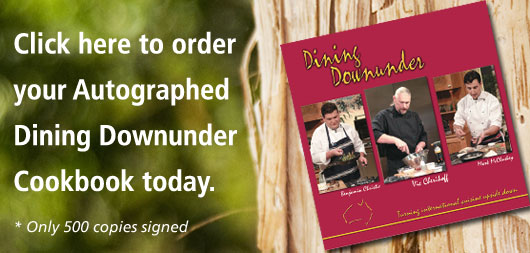 Australian Celebrity Chefs, Vic Cherikoff and Benjamin Christie last week signed only 500 copies of their Dining Downunder Cookbook exclusively for online orders in December or until sold out.
Australian Celebrity Chefs, Vic Cherikoff and Benjamin Christie last week signed only 500 copies of their Dining Downunder Cookbook exclusively for online orders in December or until sold out.
The signed Dining Downunder Cookbook are now in the warehouse and are ready for shipping today. There has never been a better time to buy a copy for you, friends and family.
For those that haven’t seen the Dining Downunder Cookbook there is over ninety beautifully photographed recipes from the show and provides a visual feast for the senses and includes detailed descriptions on how to use the many native ingredients including wattleseed, Lemon Myrtle Sprinkle, Alpine pepper, paperbark, lemon aspen juice and Riberry Confit. Also featured are recipes from the restaurants the chefs visit.
Those who frequently entertain at home or are gourmet enthusiasts will find The Dining Downunder Cookbook a must and will appreciate the easy to follow recipes and informative guides, including the secrets of an Australian barbeque.
Our Christmas Gift to you this year is simply purchase a copy of the Dining Downunder Cookbook as well as something else from our online store and we’ll give you 10% off your total order.
Use the code XMAS06 – 10% off your order code
To browse and buy at our online store visit www.dining-downunder.com/shop/
Vic Cherikoff and Benjamin Christie have recently returned from their 8-day cruise onboard the Regent Seven Seas Mariner from Darwin to Sydney where they showcased an Australian themed cuisine event as part of the Mariner’s “Spotlight on Wine & Food Tour”.
Cruise Director, Barry Hopkins interviewed Vic and Benjamin on the ship’s in house TV channel, Mariner Today, which is a recent addition to the cruise ship. Mariner Today is hosted by Barry and begins the day by detailing events about the cruise ship and what not to miss. The show also features interviews with Cruise Staff, Guests and even the Captain. Each day the show is filmed in different locations on the ship, dependent on the focus for the day.
The interview goes for about 10 minutes and Vic and Benjamin talk about some of the unique flavours they used for the cooking classes and dinner on board the ship earlier this month.
As part of this event, Vic and Benjamin hosted a native Australian dinner (read their menu below) and cooking classes which featured selected dishes from their menu:
– Wattleseed infused beef fillet with paperbark smoked mash & riberry confit
– Paperbark Smoked Vegetable Parcel served with Bush Tomato Chutney
Guests were also able to purchase signed Dining Downunder Cookbooks, our range of herbs, spices & seasonings, sauces and Vic’s newly developed Rainforest Mist facial spray.
Congratulations to Kylie Jones from NSW, Australia who was the winner of the October Furi Bread Knife as part of our monthly giveaway.
If you would like a chance to win a Furi 20cm Cooks Knife, simply subscribe to our monthly newsletter to go into the draw.
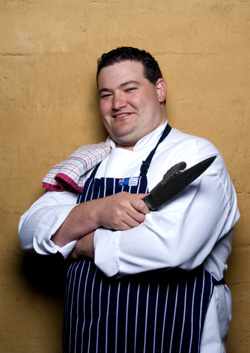 The Heart Foundation of Australia recently approached Benjamin Christie to be a part of their Heart Classic Golf Day on Thursday 16th November 2006 which will be held at one of Australia’s most prestigious courses, The Lakes Golf Club.
The Heart Foundation of Australia recently approached Benjamin Christie to be a part of their Heart Classic Golf Day on Thursday 16th November 2006 which will be held at one of Australia’s most prestigious courses, The Lakes Golf Club.
The day is designed to provide an excellent opportunity for businesses to profile themselves within Australia, entertain key clients or as a networking opportunity to build new business contacts – whilst raising much needed funds for the Heart Foundation.
After the Heart Classic Golf Day, a Grand Auction Dinner will be held to raise funds. Benjamin has offered a prize to have him in your home creating a personalised 3-course menu featuring Australian native flavours for 8 people.
This is a great Christmas gift or corporate gift, whilst raising much needed funds for The Heart Foundation of Australia.
For more information about this exclusive event, promotional opportunities and hole sponsorship please visit the Australian Heart Foundation.
The Heart Foundation is Australia’s leading heart health charity and is funded almost entirely by donations and bequests. Over 50 percent of the Heart Foundation’s income is from bequests alone. Cardiovascular disease (heart, stroke and blood vessel disease) is the leading cause of death and disability in Australia, or 38% of all deaths. Around 3.67 million Australians are affected by cardiovascular disease and 1.10 million Australians are disabled long-term by cardiovascular disease.
 To find out how you can make a donation to the Heart Foundation please visit the Heart Foundation
To find out how you can make a donation to the Heart Foundation please visit the Heart Foundation
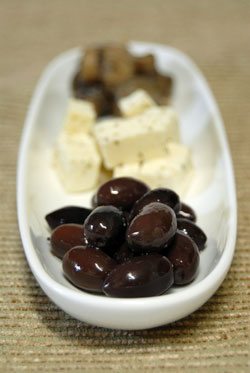 Paperbark Smoke Oil is a uniquely Australian and deliciously flavoured infused oil, which is used in the same way as truffle oil but is far more versatile and widely appealing. It is made from Paperbark, the outer papery bark from an Australian swamp tree and which was traditionally used by Aborigines as a food wrap. In the modern kitchen, Paperbark is a useful, natural, biodegradable material which can replace greaseproof paper, baking paper, oven bags, plastic wrap and aluminium foil while imparting a delicate smokey flavour now infused into Paperbark Smoke Oil.
Paperbark Smoke Oil is a uniquely Australian and deliciously flavoured infused oil, which is used in the same way as truffle oil but is far more versatile and widely appealing. It is made from Paperbark, the outer papery bark from an Australian swamp tree and which was traditionally used by Aborigines as a food wrap. In the modern kitchen, Paperbark is a useful, natural, biodegradable material which can replace greaseproof paper, baking paper, oven bags, plastic wrap and aluminium foil while imparting a delicate smokey flavour now infused into Paperbark Smoke Oil.
For years, Cherikoff Rare Spices had been sending Paperbark to their distributor in the USA with no problem or concern and had built up quite a market there. “Unfortunately, this all stopped when the USDA decided that our product be banned as an environmental threat. So in an effort to address both challenges of environmental restrictions and imparting flavour with ease, I developed Paperbark Smoke Oil using canola oil, infused with the natural smoke flavour of Paperbark” says Vic Cherikoff.
Paperbark Smoke Oil is cholesterol free and it is used so sparingly that the added oil hardly matters as dietary fat. It is ideal for fish, shellfish, meat and vegetables, condiments, dressings; effectively it can be used in any dish that a subtle hint of smoke would enhance. Try a drizzle over roasted corn on the cob, or a dash in a seeded, Dijon style mustard. This turns an ordinary condiment into something really special. Add a splash of Paperbark Smoke Oil to your favourite sauce (just before serving) or soup.
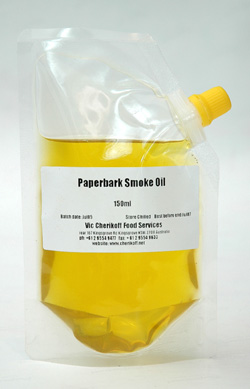 “I enjoy using Paperbark Smoke Oil in ordinary sauces like hollandaise or mayonnaise as it offers a much more interesting flavour. I’ve also made fantastic smoked chocolate ice cream or smoked crème anglais” says Australian celebrity chef, Benjamin Christie.
“I enjoy using Paperbark Smoke Oil in ordinary sauces like hollandaise or mayonnaise as it offers a much more interesting flavour. I’ve also made fantastic smoked chocolate ice cream or smoked crème anglais” says Australian celebrity chef, Benjamin Christie.
We invite you to visit our online store for Paperbark Smoke Oil and other authentic Australian products and we welcome anyone to submit recipes using our ingredients.
Packaged in a 150ml spouted bag Paperbark Smoke Oil is easily ordered through our online store and shipped around the world or ordered through our global distribution network for food service sales.
Paperbark Smoke Oil Recipes
Asparagus with Paperbark Smoke Hollandaise
Feta cheese marinated with Paperbark Smoke Oil
Kalamata Olives enhanced with Paperbark Smoke Oil
Marinated mushrooms with Paperbark Smoke Oil
Mashed Potato with Paperbark Smoke Oil
Seeded Mustard with Paperbark Smoked Oil
 Paperbark Smoke Oil is a uniquely Australian and deliciously flavoured infused oil, which is used in the same way as truffle oil but is far more versatile and widely appealing. It is made from Paperbark, the outer papery bark from an Australian swamp tree and which was traditionally used by Aborigines as a food wrap. In the modern kitchen, Paperbark is a useful, natural, biodegradable material which can replace greaseproof paper, baking paper, oven bags, plastic wrap and aluminium foil while imparting a delicate smokey flavour now infused into Paperbark Smoke Oil.
Paperbark Smoke Oil is a uniquely Australian and deliciously flavoured infused oil, which is used in the same way as truffle oil but is far more versatile and widely appealing. It is made from Paperbark, the outer papery bark from an Australian swamp tree and which was traditionally used by Aborigines as a food wrap. In the modern kitchen, Paperbark is a useful, natural, biodegradable material which can replace greaseproof paper, baking paper, oven bags, plastic wrap and aluminium foil while imparting a delicate smokey flavour now infused into Paperbark Smoke Oil.
For years, Cherikoff Rare Spices had been sending Paperbark to their distributor in the USA with no problem or concern and had built up quite a market there. “Unfortunately, this all stopped when the USDA decided that our product be banned as an environmental threat. So in an effort to address both challenges of environmental restrictions and imparting flavour with ease, I developed Paperbark Smoke Oil using canola oil, infused with the natural smoke flavour of Paperbark” says Vic Cherikoff.
Paperbark Smoke Oil is cholesterol free and it is used so sparingly that the added oil hardly matters as dietary fat. It is ideal for fish, shellfish, meat and vegetables, condiments, dressings; effectively it can be used in any dish that a subtle hint of smoke would enhance. Try a drizzle over roasted corn on the cob, or a dash in a seeded, Dijon style mustard. This turns an ordinary condiment into something really special. Add a splash of Paperbark Smoke Oil to your favourite sauce (just before serving) or soup.
 “I enjoy using Paperbark Smoke Oil in ordinary sauces like hollandaise or mayonnaise as it offers a much more interesting flavour. I’ve also made fantastic smoked chocolate ice cream or smoked crème anglais” says Australian celebrity chef, Benjamin Christie.
“I enjoy using Paperbark Smoke Oil in ordinary sauces like hollandaise or mayonnaise as it offers a much more interesting flavour. I’ve also made fantastic smoked chocolate ice cream or smoked crème anglais” says Australian celebrity chef, Benjamin Christie.
We invite you to visit our online store for Paperbark Smoke Oil and other authentic Australian products and we welcome anyone to submit recipes using our ingredients.
Packaged in a 150ml spouted bag Paperbark Smoke Oil is easily ordered through our online store and shipped around the world or ordered through our global distribution network for food service sales.
Paperbark Smoke Oil Recipes
Asparagus with Paperbark Smoke Hollandaise
Feta cheese marinated with Paperbark Smoke Oil
Kalamata Olives enhanced with Paperbark Smoke Oil
Marinated mushrooms with Paperbark Smoke Oil
Mashed Potato with Paperbark Smoke Oil
Seeded Mustard with Paperbark Smoked Oil
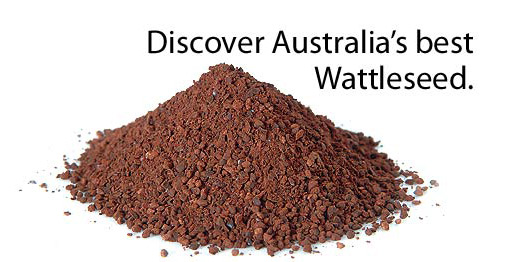 For over 6000 years, Australian Aborigines in different clans around the country, parched and milled wattle seeds from around 100 of the 900 plus species of Acacia, then used the coarse flour in baked seed cakes. This all changed in 1984, when the accidental discovery by
For over 6000 years, Australian Aborigines in different clans around the country, parched and milled wattle seeds from around 100 of the 900 plus species of Acacia, then used the coarse flour in baked seed cakes. This all changed in 1984, when the accidental discovery by
Vic Cherikoff created the modern day product known as Cherikoff Wattleseed).
This is more of a flavouring (natural of course) made from nothing but specially selected species of wattle seeds, carefully and artfully roasted using a particular temperature regime to bring out a wonderful and specific profile of Maillard flavour products which we so love in chocolate, baked foods and roasted nuts. The Wattleseed is then ground, again employing specially developed technologies so that the resultant particle size is small enough for maximal flavour extraction in a wide variety of uses but not so fine as to impart a dusty character on the tongue. This research and refinement of the product makes Cherikoff Wattleseed indisputably the best on the market. The proof of this claim is that it is now highly regarded globally by creative chefs and innovative manufacturers for the unique coffee, chocolate and hazelnut flavours that it imparts.
 These days, Cherikoff Wattleseed is used extensively around the world from mainstream bakers in Europe to fine dining restaurants, specialty chocolatiers and ice cream manufacturers in New York. Celebrity chefs such as Emeril Lagasse made Cherikoff Wattleseed ice cream on his TV show; Peter Gordon (of NZ and UK fame) uses it in his London eatery (in his signature dish); Graham Kerr has used it for his new, low fat, super healthy cuisine on his most recent TV series; and now Luis Diaz at Wolfgang Puck’s Chinois is about to grasp the flavour impact of it is his cooking. Wattleseed Anzacs biscuits on QANTAS flights are now an iconic inclusion and recently Wattleseed was served to Queen Elizabeth II on her recent visit to Australia. And this is just a smattering.
These days, Cherikoff Wattleseed is used extensively around the world from mainstream bakers in Europe to fine dining restaurants, specialty chocolatiers and ice cream manufacturers in New York. Celebrity chefs such as Emeril Lagasse made Cherikoff Wattleseed ice cream on his TV show; Peter Gordon (of NZ and UK fame) uses it in his London eatery (in his signature dish); Graham Kerr has used it for his new, low fat, super healthy cuisine on his most recent TV series; and now Luis Diaz at Wolfgang Puck’s Chinois is about to grasp the flavour impact of it is his cooking. Wattleseed Anzacs biscuits on QANTAS flights are now an iconic inclusion and recently Wattleseed was served to Queen Elizabeth II on her recent visit to Australia. And this is just a smattering.
Numerous Aboriginal communities along with some dedicated, contracted non-Aboriginal harvesters now gather the small wattle seeds across more than a million square miles (kilometres if you must) of country. While plantations are about to begin yielding reasonable quantities of wattle seed, the mechanical harvesting methods trialled so far have not yet provided the most ideal system. Everything from vacuum to combine harvesters have been developed, modified and tested but there is still more work in this area to do. Without doubt, as the market for tonnage grows, the imperative to engineer the best yielding harvesters will grow too and this time is getting nearer as new markets for Cherikoff Wattleseed are found and developed.
While nutrition has little to do with most people’s food choices, Wattleseed is a great inclusion in anyone’s diet. It has an unusually low glycaemic index which means that the carbohydrates in it are slowly absorbed and therefore better for you than sugary, quick release alternatives. Wattleseed can also be incorporated into foods to lower the overall GI and either just improve its nutritional value or to actually make some food acceptable for people with non-insulin dependent diabetes.
 But for anyone who simply enjoys great food, Cherikoff Wattleseed is well suited for a wide range of dishes, sauces and condiments. Either in dry form or as the liquid extract, Wattleseed can be used in sauces, rubs and marinades, crumbs, coatings and batters. It’s superb in baked foods such as breads, biscuits, muffins and cakes and also in desserts including custard and custard desserts, bread and butter puddings, crème patisserie and of course, the now famous, rolled Wattleseed pavlova. Wattleseed is terrific in pancakes, waffles, crumpets, scones, bagels or pretzels; also in dairy desserts with Wattleseed ice cream being a certain world flavour soon and even Wattleseed drinking yoghurt, flavoured milk and soy milk are worth trying. And last but not least is the use of Wattleseed in beverages. Try it as an espresso or simply boiled briefly and strained (unlike coffee, Wattleseed can handle boiling temperatures). I find it better with milk as it brings out some sweetness and rounds out the flavour. It’s good blended with coffee if you need the caffeine hit and there are companies already marketing Wattleseed chai. However, one of my favourite uses is to add 1% Cherikoff Wattleseed extract to a mild flavoured beer (not too hopped).
But for anyone who simply enjoys great food, Cherikoff Wattleseed is well suited for a wide range of dishes, sauces and condiments. Either in dry form or as the liquid extract, Wattleseed can be used in sauces, rubs and marinades, crumbs, coatings and batters. It’s superb in baked foods such as breads, biscuits, muffins and cakes and also in desserts including custard and custard desserts, bread and butter puddings, crème patisserie and of course, the now famous, rolled Wattleseed pavlova. Wattleseed is terrific in pancakes, waffles, crumpets, scones, bagels or pretzels; also in dairy desserts with Wattleseed ice cream being a certain world flavour soon and even Wattleseed drinking yoghurt, flavoured milk and soy milk are worth trying. And last but not least is the use of Wattleseed in beverages. Try it as an espresso or simply boiled briefly and strained (unlike coffee, Wattleseed can handle boiling temperatures). I find it better with milk as it brings out some sweetness and rounds out the flavour. It’s good blended with coffee if you need the caffeine hit and there are companies already marketing Wattleseed chai. However, one of my favourite uses is to add 1% Cherikoff Wattleseed extract to a mild flavoured beer (not too hopped).
Manufacturers are already using Cherikoff Wattleseed in many of the above applications in commercial and retail products and much of our work is in assisting companies bring out the best in their new product development using this great flavour. And to give you a little insight into the future, we are now looking at new Wattleseed extracts made with liquid carbon dioxide (sub-critical CO2) extraction techniques. These give us concentrated flavours which can be used in low moisture applications (confectionery, chocolate, cheeses, honey etc).
Cherikoff Wattleseed is currently available to chefs and manufacturers in two forms, either as Wattleseed (a milled product like coffee grounds as described previously) or Wattleseed extract which is more convenient and easier to use.
Wattleseed is available online for delivery right around the world. To order, simply visit the
Dining Downunder online store
 Vic has been told that there is nothing like his new product on the market. Nothing legal anyway. Rainforest Mist by Vic Cherikoff is a totally new, natural functional lifestyle product designed to remind you that you are alive!
Vic has been told that there is nothing like his new product on the market. Nothing legal anyway. Rainforest Mist by Vic Cherikoff is a totally new, natural functional lifestyle product designed to remind you that you are alive!
Just like taking a deep breath in a pristine rainforest, your senses will burst to life. Using ancient Aboriginal plant lore and modern science, Vic has infused Australian rainforest herb and fruit extracts into pure ice crystal water to create a natural face mist you inhale and that goes way beyond refreshing.
Rainforest Mist by Vic Cherikoff is predicted to spread around the world, driven by the demands of our modern lifestyles because;
• if you ever need to work hard or for long hours
• if you just feel like you haven’t had a decent sleep for way too long
• if you travel long distances by air, road, rail or foot
• if you need to attain maximum effort in studying, physical activity or just life or
• if you occasionally lack sleep but still need to look your best
then you are reading about your new best friend: Rainforest Mist.
Perfect for hard-working chefs (or their brigades to get them working harder); apprentice chefs who need to learn heaps in a short time; restaurant patrons who just need to stay awake after a long day at work; business people; mothers; food writers on a deadline; in fact, anyone at some time will need this product.
After two and a half decades researching the herbal pharmacopoeia of the Australian Aborigines and studying the food and medicine resources of many Aboriginal communities around the country*, this product is the result.
It is at the pinnacle of combining ancient medicinal lore with the research findings of modern science and uses the superfoods of rainforest Aborigines who once lived along the eastern seaboard of Australia.
Even the water Vic has used is different. It is O18™ water from fruit juice made using a patented ice crystal extraction technology. There is no biologically purer, natural water than O18™. Ground water supplies around the world are being depleted with an immeasurable ecological cost and their quality becomes more questionable from pollution and contamination. For this reason, Vic has chosen to use an environmentally innocuous source for his water: he relies on living trees to purify and filter the water applied in clean and green plantations used for growing stands of edible fruit trees.
The fruits are harvested and processed into juice, which is chilled to near freezing in huge stainless steel columns. Ice is then introduced as a slurry of crystals and as these tiny ‘icebergs’
float up through the column of fruit juice, they grow by drawing pure water from the juice. This is the ultimate in ice crystal water which saves our precious ground water supplies for the plants and animals which depend on it. Finally, Vic chose nitrogen, which makes up 80% of the air we breathe, as an inert, non-toxic, non-oxidizing, non-flammable, ozone and environmentally friendly propellant.
Rainforest Mist is simple to use, immediately effective, more convenient (and better for you) than an energy drink or strong coffee and is calorie-free.
Australian wild fruit and native herb extracts are organically grown or wild crafted in ecologically sustainable systems. The final blend of these ancient food ingredients reflects the food-medicine blend of indigenous resources and their
powerful functionality, both nutritional and pharmacological – as nutriceuticals.
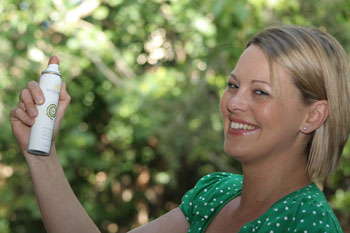 This combination of traditional knowledge, ethnobotany and pharmacology, has delivered a brand new style of product with ancient roots yet is modern, stylish, functional and affordable. It has already been praised by hard-working chefs and jet-setting travelers. However, the list of happy, dedicated users will no doubt grow quickly to include athletes and sports people, highway drivers**, dedicated students and even the elderly looking to stay mentally young and active.
This combination of traditional knowledge, ethnobotany and pharmacology, has delivered a brand new style of product with ancient roots yet is modern, stylish, functional and affordable. It has already been praised by hard-working chefs and jet-setting travelers. However, the list of happy, dedicated users will no doubt grow quickly to include athletes and sports people, highway drivers**, dedicated students and even the elderly looking to stay mentally young and active.
We hope that like others, you will discover that Rainforest Mist is a perfect fit to your lifestyle in this modern age and that you use it whenever you need to revive from travel fatigue; heavy work commitments; general tiredness; slow mornings or late nights; or just whenever you need to quickly refresh and be at your best. Pure and natural, Rainforest Mist provides that extra kick without the calories.
It has been 40,000 years in the making. It is now available in the online store see Rainforest Mist and we look forward to your feedback on how it fits your lifestyle.
*A portion of profits from Rainforest Mist benefits remote region Aboriginal communities and provides opportunities in their commercialisation of Australian natural resources.
**Remember, authorities recommend that when driving long distances you should ‘stop, revive and survive’ every two hours.
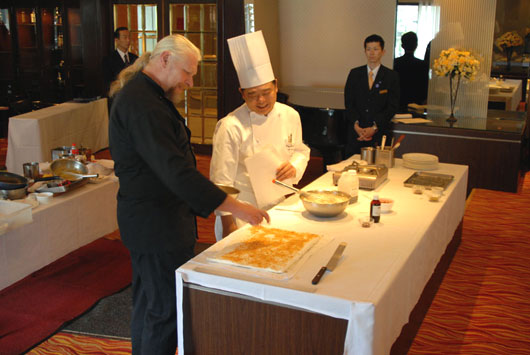 Food Festivals are a great way of giving your patrons new and powerful memories they’ll remember for a long time.
Food Festivals are a great way of giving your patrons new and powerful memories they’ll remember for a long time.
Well-planned and executed food festivals can introduce regulars and new visitors to your hotel, resort, conference, food show or other venue to sample delicious flavours, impress them with outstanding food, exceptional wines and beers and provide a glimpse of far away cultures, exotic cuisines or the latest trends in food. Australian food festivals can go even further.
Dining Downunder Promotions celebrity chefs, Vic Cherikoff and Benjamin Christie are the world’s leading specialists in Australian cuisine from its ancient origins as sustenance for generations of Australia’s Aborigines; to Vic’s experience in pioneering the native Australian food industry; and Benjamin’s international experience in using Australian ingredients while cooking in 4 and 5-star hotels and resorts around the world.
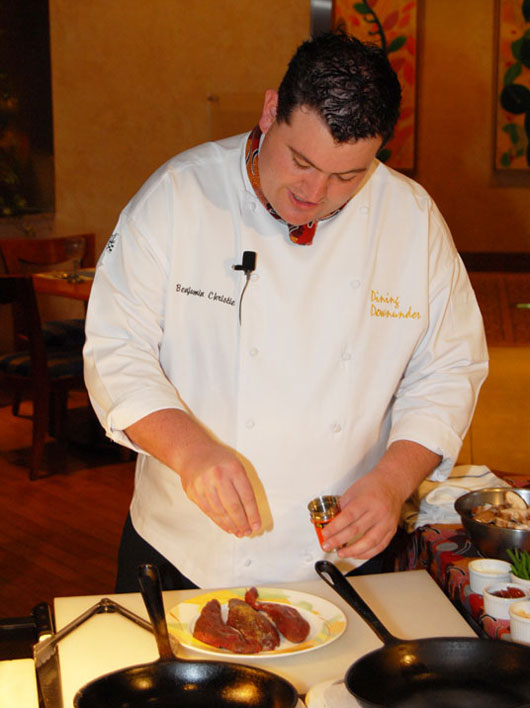 Together they have the industry’s longest collective involvement in the development, use and presentation of Australia’s unique culinary ingredients. Their standing as specialist celebrity chefs also widely promotes Australia as a culinary tourism destination and a place where the food culture is strong, vibrant, exciting and captivating.
Together they have the industry’s longest collective involvement in the development, use and presentation of Australia’s unique culinary ingredients. Their standing as specialist celebrity chefs also widely promotes Australia as a culinary tourism destination and a place where the food culture is strong, vibrant, exciting and captivating.
Both Vic and Benjamin are highly experienced in providing professional cooking demonstrations for all levels of culinary interests; from home cooks through to Michelin star chefs from the world’s best restaurants. They will tailor the presentation to your needs and to the audience while entertaining, edifying and feeding them. You might consider participatory cooking classes or ingredient hamper inclusions for each participant or the co-promotion of other produce, equipment, services or events.
Whatever type of food festival or event you are planning, our Australian celebrity chefs are available to introduce the modern trend of the newest foods from the oldest living culture on the planet.
For enquiries please contact Rebecca Beuth
 Today Vic Cherikoff departed from Sydney heading to The Natural Products Expo East, being held in Baltimore, Maryland, USA from 4th – 7th October.
Today Vic Cherikoff departed from Sydney heading to The Natural Products Expo East, being held in Baltimore, Maryland, USA from 4th – 7th October.
The Natural Products Expo is the largest East Coast trade show for this industry and a “must attend” for retailers and journalists. New products in this industry are launched at the Natural Products Expo, being one of the main reasons that Vic is attending.
 Vic will be showcasing his newly developed Rainforest Mist, which is a totally unique, natural functional lifestyle product designed to remind you that you are alive!
Vic will be showcasing his newly developed Rainforest Mist, which is a totally unique, natural functional lifestyle product designed to remind you that you are alive!
He will also be showcasing his native Australian products such as Alpine Pepper, Lemon Myrtle, Wattleseed and many more. Read more about these products at www.cherikoff.net.
Visit the Vic Cherikoff Stand No.4723
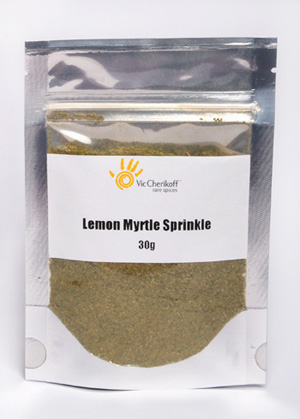 Lemon Myrtle Sprinkle is a deliciously aromatic and extremely versatile herb mix is made from lemon myrtle, one of the most well known Australian herbs and spices probably because of its similarity to lemon grass, lime and lemon oils – all widely used flavors themselves. Lemon myrtle has an intensity and a sweetness of smell which makes it more lemony than lemon!
Lemon Myrtle Sprinkle is a deliciously aromatic and extremely versatile herb mix is made from lemon myrtle, one of the most well known Australian herbs and spices probably because of its similarity to lemon grass, lime and lemon oils – all widely used flavors themselves. Lemon myrtle has an intensity and a sweetness of smell which makes it more lemony than lemon!
Lemon Myrtle Sprinkle is considered even more lemony than lemon myrtle because of its unique formulation. It is a blend of the best quality lemon myrtle leaf; wild lime pulp (specially freeze-dried and milled at sub-zero temperatures) and which provides just a hint of acid; and Vic Cherikoff has added in more lemon myrtle using encapsulated lemon myrtle and lemon myrtle essential oil. Finally, some aniseed myrtle was added which is a great tonic herb and immune system stimulant.
This results in a mix which is probably closer to 200% more effective as lemon myrtle leaf alone and a more rounded flavour as well.
But back to the lemon myrtle in Lemon Myrtle Sprinkle. This ‘herb’ comes from a tall rainforest tree (up to 30m) and once was only found in SE Queensland, from Brisbane to Cairns but is now widely planted in coastal New South Wales and some even in South Australia, Victoria as well as our coldest State, Tasmania. The growth rate is highest in warmer climates but leaf quality can vary with plant nutrition, watering regimes, the weather, time of day and harvest cycles.
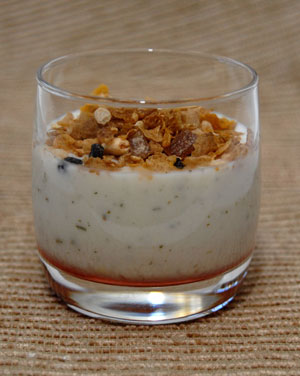 The leaves are now more-often machine harvested for the food, cosmetic, fragrance and cut flower industries. Some growers still pick by hand, particularly for cottage industry products such as oils and vinegars where a whole leaf may be added as a garnish. Generally, though, larger scale manufacturers look to the distilled essential oil which might be solubilised or encapsulated for functionality and ease of use.
The leaves are now more-often machine harvested for the food, cosmetic, fragrance and cut flower industries. Some growers still pick by hand, particularly for cottage industry products such as oils and vinegars where a whole leaf may be added as a garnish. Generally, though, larger scale manufacturers look to the distilled essential oil which might be solubilised or encapsulated for functionality and ease of use.
So for culinary uses as an all-purpose, sweet or savoury lemon seasoning, Lemon Myrtle Sprinkle can be used in an unlimited number of ways.
As a herb tea, just infuse to your own taste in boiling water or tea. It can also be added to a freshly brewed, super-strong coffee as it brings out the flavor of the coffee itself and adds those heady aromatics of citral to complement the coffee. It’s also very good in hot chocolate. Try Lemon Myrtle tea with ginger juice, black or green tea, rooibos or other herbals and even chill and gas it with a soda stream to make your own soft drinks. (Add sugar or fruit juice and sweeten it to taste).
As a lemon spice, Lemon Myrtle Sprinkle is best used as a finishing seasoning. Simply add it to hot or just-cooked food before serving and the essential oils are driven out by the warmth to reach your tastebuds. So if you bake chicken or fish, add a sprinkle of Lemon Myrtle Sprinkle as
it comes out of the oven and it’ll be
full-flavored by the time it gets to the table.
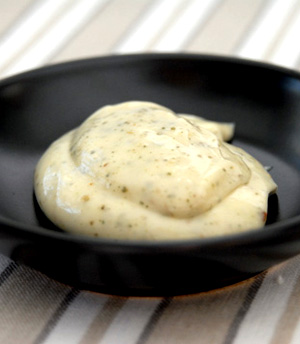 As a flavouring, say, in custards or any soft cheeses, clotted cream, yoghurt or other dairy product you can just add it to taste or infuse the flavor out by infusing some Lemon Myrtle Sprinkle in warmed milk and add this as a concentrate. You can obviously make this as strong as you like and by leaving it stand for up to 10 minutes, out comes the essential oils and up goes the flavor.
As a flavouring, say, in custards or any soft cheeses, clotted cream, yoghurt or other dairy product you can just add it to taste or infuse the flavor out by infusing some Lemon Myrtle Sprinkle in warmed milk and add this as a concentrate. You can obviously make this as strong as you like and by leaving it stand for up to 10 minutes, out comes the essential oils and up goes the flavor.
You can replace the milk with sugar syrup (say, 500ml water and 500g sugar dissolved by heating the stirred mixture slowly) and use this over stewed fruits, ice cream (or to make your own ice cream), thicken it with agar agar or gelatine to make a soft jelly or add lemon juice and turn it into a lemon spread with the pectin.
Here are some Lemon Myrtle recipes;
Cauliflower soup with marron scented with Ferguson’s lobster oil and Lemon Myrtle
Ginger prawn and noodle salad
Grilled Wild Barramundi Fillet with Lemon Myrtle mash and Quandong Confit
Kangaroo Lasagne with Bush Tomato Chutney and Lemon Myrtle
Lemon Myrtle Hollandaise
Lemon Myrtle Mayonnaise
Lemon Myrtle Yoghurt with Riberry Confit and Cereal
Paperbark smoked snapper fillets with Daintree pineapple and riberry salsa
Rainforest lime and macadamia nut pudding
Ricotta figs and macadamia nuts
Seafood Laksa with wild limes and lemon myrtle linguini
Store your Australian Lemon Myrtle Sprinkle in the freezer to keep it fresh for years – although you’ll probably discover so many ways to use it there’s no way it’ll stay unused for that long!
Lemon Myrtle is packaged in either a 30g sachet or jar it is easily ordered through our online store and shipped around the world or ordered through our global distribution network for food service sales.
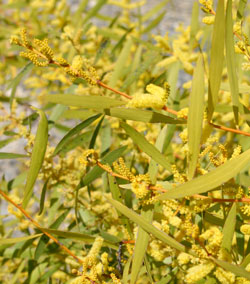 Wattle Day began in the late 1880’s with the suggestion of a formation of the Wattle Blossom League by William Sowden (an Adelaide journalist and Vice President of the Australian Natives Association in South Australia). The aim, recorded in 1890, was to “promote a national patriotic sentiment among the women of Australia”. The most visual way of acknowledging this was for women to wear sprigs of wattle at all official occasions. Unfortunately the group dissolved, however their presence had inspired the formation of a Wattle Club in Melbourne.
Wattle Day began in the late 1880’s with the suggestion of a formation of the Wattle Blossom League by William Sowden (an Adelaide journalist and Vice President of the Australian Natives Association in South Australia). The aim, recorded in 1890, was to “promote a national patriotic sentiment among the women of Australia”. The most visual way of acknowledging this was for women to wear sprigs of wattle at all official occasions. Unfortunately the group dissolved, however their presence had inspired the formation of a Wattle Club in Melbourne.
The concept of Wattle Day grew stronger and spread to NSW where the Director of the Botanic Gardens, J H Maiden called a public meeting with the aim of forming a Wattle Day League. As a result, the first observed Wattle Day was held on 1 September 1910 in Sydney, Melbourne and Adelaide.
Aside from celebrating being Australian, the Australian environment and history, Wattle Day generally relates to Spring and looking forward.
“However in 1917 the date was changed to 1 August due to an early spring that year, but in 1937 another date change back to 1 September being the start of the school holidays.
Botanists can’t quite agree but there appears to be around a 1000 species of Acacia which are colloquially called wattles by Australians. Another 700 species, mostly quite distinct from the Australian ones, are also found in Africa.
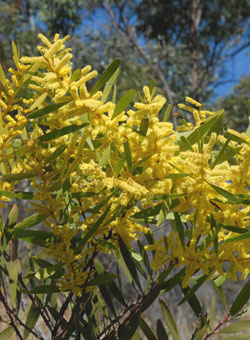 Wattleseed from around 120 species of Acacia have been used as foods by Australian Aborigines for at least 6,000 years. This matches the first cultivation of wheat on the fertile deltas at the mouths of the Nile in Egypt; the Euphrates in Mesopotamia (now Iraq); and the Indus in India. However, while the move to cultivation began a trend of reliance on an ever-decreasing number of food species, Australian Aborigines maintained a completely different relationship with the Land. They saw themselves as part of the ecosystem and did not attempt to conquer it. They were managers and care-takers of their country. As part of their charge of keeping the country healthy, they used a huge array of different foods to meet their nutritional needs and for numerous Aboriginal clans, wattle seeds were just a part of this food resource.
Wattleseed from around 120 species of Acacia have been used as foods by Australian Aborigines for at least 6,000 years. This matches the first cultivation of wheat on the fertile deltas at the mouths of the Nile in Egypt; the Euphrates in Mesopotamia (now Iraq); and the Indus in India. However, while the move to cultivation began a trend of reliance on an ever-decreasing number of food species, Australian Aborigines maintained a completely different relationship with the Land. They saw themselves as part of the ecosystem and did not attempt to conquer it. They were managers and care-takers of their country. As part of their charge of keeping the country healthy, they used a huge array of different foods to meet their nutritional needs and for numerous Aboriginal clans, wattle seeds were just a part of this food resource.
Traditionally, Australian Aboriginal women generally harvested the fully ripe, dry seeds from the wattle, collecting them as we still do today – by beating the pod-laden trees with sticks to dislodge the seeds. Some species were eaten at the green pod stage but dried seeds were by far more common.
Rather than the wattle seeds falling on cleared earth, modern harvesters spread shadecloth or tarpaulins under the trees and scoop up the pods and seeds (and the inevitable sticks, beetles and leaves) and stockpile it all for collection and cleaning. Various and ingenious mechanical harvesters have been used with varying degrees of success, from tractor power take-off driven vacuums to backpack units. Some even clean the seeds up in the field. This reduces the vast volumes of pods transported back to camp as a 1 cubic metre wool bale full of pod can hold as little as from 10 to 15 kg of seeds once cleaned (about a bucket full).
Back in ancient times, the seeds were collected in coolamons or bark dishes and hot live coals were added to heat parch the seeds. This makes them easier to mill to a flour otherwise the seeds tend to squash as though you were trying to mill fresh garden peas. Once adequately toasted and dried, the coals were removed and the coolamons used to yandy and bump the seeds clean from any debris. We use modern equivalents like huge fans and vibrating table sieves to clean the seeds and then roast them in modified coffee roasters. Anyway, the Aboriginal processed seeds were milled to a coarse meal which was then baked into seed cakes.
The modern use of wattle seeds came about when Vic Cherikoff was preparing the seeds from 4 or 5 wattle species he’d had sent in from Central Australian Aboriginal communities with whom he was working on the nutritional analysis program at the University of Sydney. The Aboriginal women had sent in raw seeds and while these were useful to analyse, he also needed the seeds as prepared ready to eat.
And so he found himself roasting the seeds in a saucepan on his kitchen stove. He heated the seeds while tossing them around and heard a few popping noises as the seeds super-heated inside their seed coat and then suddenly released the energy as the seed coat popped. He then transferred the roasted seeds to an electric coffee bean grinder and gave them a spin before taking off the top to look at how they’d ground up. What an aroma! Up came this incredible, coffee, chocolate, hazelnut, toasty, roasted flavour which was just superb. Vic then ground the seeds up more and tried the dark brown, coffee-like grounds in his stove-top cappuccino machine. The rich extract poured through and was then tried black, with milk and then with a topping of frothed milk and the world’s first Wattleccino™ was born. It was delicious with the milk (or cream) bringing out a sweetness in the Wattleseed. It even worked with a small amount of coffee added and this extract, which we now manufacture using state of the art, counter-current extraction technology, has been proven as a fantastic flavour for cream, ice cream, nut butters, sauces and in beverages.
Like the roasted and ground Wattleseeds, the extract can be used in a multitude of ways. A clue when using the grounds is to pre-extract the flavour and soften the grounds by boiling the small quanitity you need for the recipe in a little water. The extract is just the ready-made product with the grounds removed. The extract also has an emulsifying action and is an effective stabiliser for whipped cream, nut butters and some oil and water mixtures (sauces, particularly emulsion sauces, dressings etc).
Add Cherikoff Wattleseed to whipped cream, icecream, pancake, bread or muffin mixes, pasta, chocolate and chocolate fillings, biscuits and beverages (Wattleccino™ is simple to make with Wattleseed extract – just add hot water and frothed milk). Also use as a flavouring for beer, cream or red wine sauces, in marinades and dessert sauces. Approximate usage rate is from 2-3%, depending on the flavour of other ingredients and whether the Watttleseed is enhancing or competing with these other tastes.
Wattleseed as medicine and nutrition
The fats in wattle seeds are typically 5 to 10% of the raw seed weight but there is an interesting point to note here. Many Acacia seeds have an appendage known as an aril which is a structure which holds the seed in the pod. The arils can vary in colour from a light tan to bright yellow, orange or red. No studies have been conducted on the pigments which are probably carotenoid compounds which are related to and often precursors of vitamin A. What we do know is that the arils are very high in polyunsaturated oils and many taste absolutely delicious. In fact, some species were used by Aborigines to flavour their drinking water: The whole seeds, with arils attached, were immersed in water and worked through the fingers to almost homogenise the fats into the water. It certainly flavoured the water and I can best describe the taste as close to the toasty notes of just baked bread but with a range of interesting aromatic flavours, again, depending upon the species.
So what are you going to do on Wattle Day? Try one of these recipes and please feel free to send in your own recipes using Wattleseed and go in the draw to win a Furi Chef’s knife
Ribeye steak with broccolini, shitake mushrooms and wattleseed jus
Wattleseed Pavlova
Wattleseed Cream
Wattleccino
Paperbark Smoke Oil with Wattleseed and fresh bread
Pork Cutlets with Lemon Myrtle Hollandaise
Marinated mushrooms with Paperbark Smoke Oil
Wattleseed pancakes with riberry confit
Wattleseed and Chocolate Palmiers
Wattleseed Crocodile with riberry confit
Wattleseed and walnut bread and butter pudding with stewed fruits
Lamingtons with wattleseed cream and rosella jam
Wattleseed Creme Brulee with Quandong Confit
Anzac Biscuits with Wattleseed
Wattleseed infused Beef Fillet with Wild Rosella Jam and Kumara Mash
You can purchase Wattleseed or Wattleseed Extract from our online store.
Happy Wattle Day!
 The Daily Telegraph Newspaper recently asked Rebecca Beuth, our Executive Assistant for an interview in their careers section, as they said she has one of the more unique EA jobs in Sydney.
The Daily Telegraph Newspaper recently asked Rebecca Beuth, our Executive Assistant for an interview in their careers section, as they said she has one of the more unique EA jobs in Sydney.
So as part of the interview, the Daily Telegraph thought it might be good to do a photo shoot for the upcoming article with Vic Cherikoff and Benjamin Christie. The photo shoot was in Vic’s kitchen, which has been the venue for many photo shoots, videos, interviews and seems to always be a good location. It’s also the location where most of the native foods product development and testing is done.
The article appeared in this week’s Saturday Daily Telegraph – read the article here
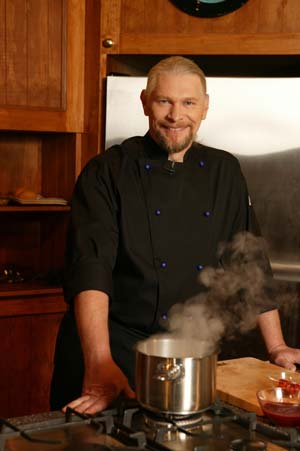 We are very excited to announce that Vic Cherikoff was recently nominated for Australian of the Year Award for 2007.
We are very excited to announce that Vic Cherikoff was recently nominated for Australian of the Year Award for 2007.
Each year our nation celebrates the achievement and contribution of eminent Australians through the Australian of the Year awards by profiling leading citizens who are role models for us all. They inspire us through their achievements and challenge us to make our own contribution to creating a better Australia.
Vic was nominated for Australia’s top award in acknowledgement of his pioneering work in the commercialization of indigenous plants, industry building, Australian cuisine development and export facilitation. He was equally stunned and humbled to hear he had been nominated.
The Australian of the Year award programme has acknowledged the contributions of many outstanding Australians and Vic hopes that anyone so motivated will write in or email their support for his nomination to tamara.johnston@australiaday.gov.au
The award ceremony will be on Australia Day, 25th January 2007 on the lawns of Parliament House in Canberra.
For more information on Vic Cherikoff and his unique Australian ingredients please visit www.cherikoff.net
For interview opportunities and press quality images, please contact Rebecca Beuth.